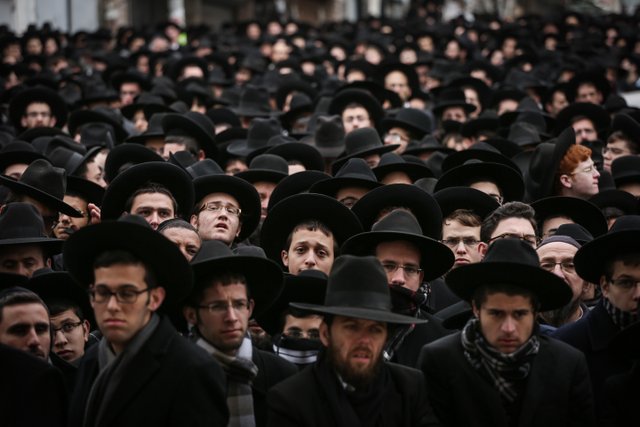Ultra-Orthodox Jews? Haredim? What does it all mean?!
To all the people who are wondering who are those "Men in Black Jews"
From my traveling Israel site : www.aviway.net

Some think that the men wearing black suits and hats are orthodox while the men dressing casually are not, this is not true, They are all Orthodox. Like you already know (or will start to learn), everything about Judaism is complex. There are many commandments and rituals and it all leads to several approaches and many arguments inside the Jewish world. As we like to say here: If there are 2 Jews, there are 3 opinions. you can find a lot of information about Judaism and the differences between the different groups, but I’ll try to sum it up for you here.
Unlike Christianity where the differences between Orthodox, Catholics, and Protestants can be quite big with different holy dates, prayers, and beliefs. Similar in Islam between Sunnis and Shias in Islam. A religious Jew who wears a black suit, one who wear just casual clothes will all celebrate the same holidays on the same dates, say the same prayers, and can pray together in a synagogue. Although, because of their different life perspectives and political views, they’ll usually live in separate communities.
In Hebrew - Haredim (חרדים)
Generally, the ones wearing black clothes are called Haredim. Haredim means afraid or anxious. It refers to the modern lifestyles and reforms reform. They choose to stay in their communities and avoid the influence of the outside world. Being conservative is part of their ideology and wearing their old-fashioned clothes is a way to distinguish themselves from their environment. Wearing black is a color that isn’t prominent and it’s modest.
Hasidim vs Mitnagdim - Soul VS Brain
Among the Haredim, the first differences will be between Hasidim and Mitnagdim.
Very generally, the Hasidim want to make the religion more approachable to people. Judaism is a lot about studying, being clever, and understanding some very complex ideas.
Some spend the whole day and whole night analyzing texts and studying. In the 18 century, there was a big rabbi who started to make advanced ideas in Judaism, like Kabbalah, more approachable to people. He communicated that worshiping God is not only about studying but also about daily acts you do in the physical world.
Slowly, slowly this movement grew and appealed to many. Not everyone is born smart or capable of studying all day complex texts. The focus here is not on knowledge and analytical ability, but more on good intentions and being passionate about God and prayers. For example, you can have vast knowledge and good studying ability, but if you live and pray in a mechanical way without a soul, it's pointless.
The Hasidim will say that a person who prays passionately with all of his heart is still close to God. The Mitnagdim will say that a prayer without knowledge is empty, and with a lack of knowledge, you will forget how to do it properly…
Hasidim will also make their celebrations big, with alcohol dancing and a lot of toasts. Mitnagdim represents the classical approach to Judaism. They are called opposites (Mitnagdim) because they oppose the rise of the Hasidic movement. They are also called Litaim, (meaning Lithuanians in Hebrew) because some of their great rabbis come from Lithuania.Oh, and did I mentioned that the Hasidim split into subgroups depending on their Rabbi, ideology, and location?
A documentary of one of the most famous Litaim yeshiva (school):
Short Tales:
- When the Messiah will come, the Lita'im will run to him with some scriptures and ask him about all the things they don't understand. The Hassidim will run to him with a bottle of vodka containing the last few drops...
- A Hasid and a Litai are having an argument about which Rabbi is greater. The Litai… say “If the Messiah comes and says we’re right, what will your Rabbi do?”
The Hasidim say “My rabbi will stop doing the Hasidic traditions and will sit all day and do nothing except study the Torah. I'm sure that in 10 years he will be as good as your rabbi.” “And what if the Messiah will say that the Hassidim are right? What your rabbi will do?” The Litai… answered “Well my rabbi will drop all of his studying and will start to focus on the Hassidic way of life. After 10 years, I’m sure he will be good as your rabbi.” The Hasid answered, “maybe, but to be a simple man like my rabbi I don’t think 10 years is enough.”
Anti-Zionism vs Assimilation
Some of Hassidim like “Neturei Karta” or “Satmer” are anti-Zionist and against the state of Israel. According to their view, God punished the Jews by expelling them 2000 years ago and only God will establish a new Jewish state. And besides, they can’t accept that the state is not a religious state. They don’t vote, they try to settle things inside the community and avoid any connection with the state Institutes. they are also openly siding with the hostile countries to Israel.On the other hand, in recent years, some of the communities have begun to take part in building the state and get closer to the rest of Israeli society, and some are joining the military. There is 1 battalion of Haredim. I generalize very much and it’s much more complex, but these are the basics.
you can read more on this page on this site.

A Neturei-Karta Hassidim. Jews but not Zionists.
The Party People
There is one group of Hasidim which you will probably meet even if you don’t go to a religious area. Theycan be found even in the center of Tel Aviv next to club entrances in remote areas of the desert or in the Israeli version of burning man. The Hasidim of Breslev. You will see a bunch of religious Jews coming in big vans with huge speakers playing hardcore trance or western hits translated into Hebrew, singing about their rabbi and about being happy. As a short generalization, one of their core ideological ideas is to spread the name and teachings of their rabbi and always be happy with a smile no matter what. His name was Nachman and he lived in Uman, Ukraine. Their slogan is “na nach Nachman me-Uman” and it’s supposed to be a quote from a mysterious letter one of the recent rabbis found that was written by Nachman himself.
just watch it and get the idea:
Dancing with soldiers:
What is actually going on there?
well, they are not part of the military of course. they see it as a duty to make the soldiers happy. they usually sneak into training grounds or rally points before any officer is noticing. having a short rave with the soldiers who are just waiting for something to break the gray depressing military daily life routine.the white head cover is giving by the Breslev and not some military symbol.Don’t get it wrong. It’s only one part of their life and most of the time they are studying scriptures, keeping commandments and living a very developed community life.
Why Ultra-Orthodox wear those black clothes?
The clothes are derived from traditions, the desire to be distinct from the environment, geographic origin, and historical laws that were passed upon the Jews in their countries in Europe.
The Litaim cloths:
from the 19-century wear suits. They had a bad economic situation in the past and they wanted to increase their value in their own eyes and their self-esteem. They started to wear suits to give themselves the look and feel of honorable people despite their situation, and this style stays with them till today. It’s just normal suits that they can buy in any fashion shop around the world.

Litaim in summer
The Hasidim cloths:
will be more conservative with their clothes. Each Hasidic movement has its own style. Most of the time their clothes look like something out of an Eastern European fashion catalog of the 18 century. High socks, all kind of coats, and a big fur hat on holidays that’s usually about only in Haredim shops. What’s the story about the hat? It is called a shtreimel and here are a few stories about it:
The king of Poland made a law that said that on their holidays, Jews have to wear the tail of an un-pure animal on their hat. So the Jews tried to make something fancy out of it and it became the fancy holiday hat and the Tzar of Russia prohibited Jews from wearing the kippah. So the Jews put fur around the kippah to hide it, and it also suited the cold weather.

A Hassid with shtreimel
Payot
why they have this weird long hair coming from the side of their head?
Well, the simple answer is because its written in the bible. The complex one is here, and it is not even the whole explanation

Hassidic children with Payot
In this video you can see a mix of everyone. Hassidim of Toldos Aharon organizing a great party each year on the holiday of Sukkot and everyone is welcome, other Hasidim, Litaim, and just random people are joining: